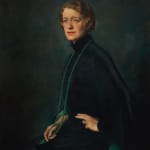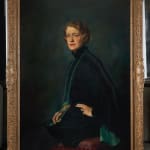Sir Oswald Hornby Joseph Birley, MC, RA, ROI British, 1880-1952
Provenance
by descent in the family of the sitter.This portrait of Dorothy, Lady Paterson (1889-1972) was completed by the prominent society painter Sir Oswald Birley (1880-1952) in 1934. Lady Paterson’s husband was Sir William Paterson (1874-1956), a Scottish mechanical engineer and the inventor of the Anderson shelter. She was a member of the Electrical Association for Women as well as an author and editor of texts that encouraged a return to a more traditional form of family life after the tumult of the Second World War.
Lady Paterson joined the Electrical Association for Women (E.A.W.) at the outbreak of the Second World War and designed an electric mobile canteen, which provided canteen service for anti-aircraft units in Great Britain. The E.A.W. was founded in 1924 with the goal of improving the lives of working and middle-class women in the home, facilitating an ‘emancipation from drudgery’ by extending the benefits of electricity to the domestic environment. In a 1934 speech, the Labour MP Ellen Wilkinson (1891-1947) declared that ‘the twin keys to women’s earthly paradise [are] the Vote and Electricity’. This organisation highlights the complex relationship between innovation and traditionalism in this period. For members like Lady Paterson, the ‘earthly paradise’ of the home could be fortified by women’s increased desire to remain in the domestic sphere, achieved as a result of electricity freeing them from the drudgery of their labours. Contrastingly, on 23 May 1930, Vote records Mrs Wilfred Ashley’s comments at a meeting of the Association, that ‘electricity was so simple and so easy that she could quite imagine that women will go to the House of Commons in increasing numbers and men will stay at home and use the cooker’.
As a society portraitist, Oswald Birley spent much of his career in the company of the fashionable and the powerful. By the 1920s he was highly sought after by both leading members of society and those seeking to establish their place within it. In 1928 he exhibited his portrait of Stanley Baldwin (1867-1947), then in his second term as Prime Minister, at the Royal Academy. After a stint painting American millionaires in New York, Birley began a commission of George V in June 1928 which was then exhibited at the Academy the following year. In 1931 he was commissioned to paint a portrait of Mahatma Gandhi (1869-1948) which was then exhibited at the Academy in 1932, and in 1934 he painted the portrait of the Duchess of York, the future Queen Elizabeth The Queen Mother, at Windsor Castle. From 1933 he had also begun to spend his summers at Charleston Manor, near West Dean in East Sussex, which was to become a hub for social gatherings of artists, musicians, and celebrities. This painting of Lady Paterson was thus executed by Birley at the height of his powers. A thriving, distinctive, and in-demand portraitist, he played a major role in defining the images of members of the social and political elite.
Bibliography:
Dorothy, Lady Paterson, The Family Woman and the Feminist: A Challenge (London: William Heinemann Medical Books Ltd for the Council of the Seven Beliefs, 1945)



